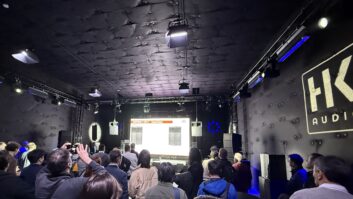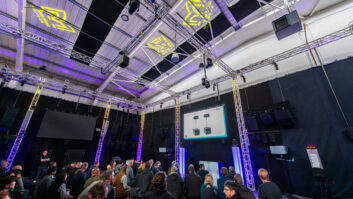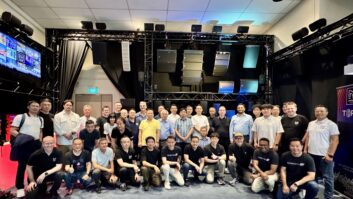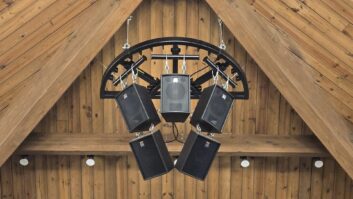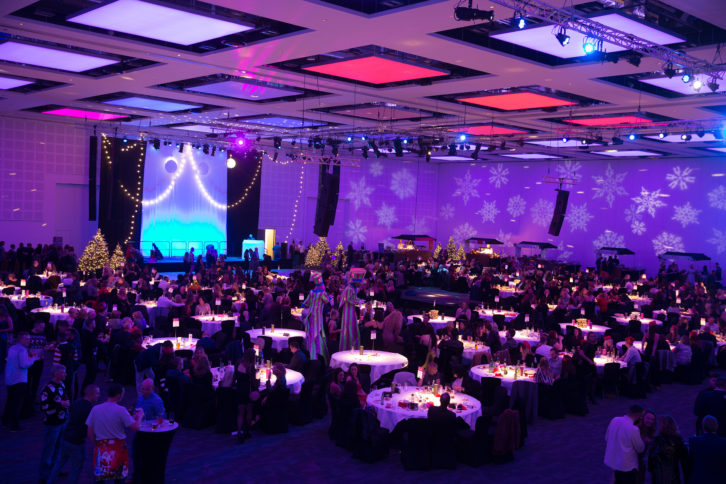
When the £84m International Convention Centre Wales (ICCW) opened in September last year, it was the first of its kind in Wales. The joint venture between the Welsh Government and the Celtic Manor Resort delivers 26,000sqm of total floorspace for meetings, conferences and exhibitions (around the size of four international rugby pitches). For visitors driving down the adjacent M4 motorway, the 10m-tall red steel dragon provides an unmistakable landmark.
Incorporated within this is a 4,000sqm, pillar-free, almost infinitely reconfigurable main hall, and it was this space that threw up many challenges for the technology contractors, Stage Electrics. Their solution was to specify an end-to-end audio workflow from the RCF catalogue, tying nearly 800 loudspeaker products (and over 1,000 RCF components in total) into a multi-use PA in the main hall and mobile systems for the meeting rooms, merged into a fully-compliant PA/VA environment.
Scope of work
With the inception of the project dating back to 2016, many technical pitfalls had to be overcome along the way by Simon Cooper and the Stage Electrics engineering team. Stage Electrics was awarded the contract in part by virtue of having worked with Celtic Manor on a number of previous occasions and by putting forward the most compelling solution to the challenges posed. The scope of work — incorporating AV, lighting (including public space), technical loose equipment and stage engineering consultancy — was set out by Russell Phillips, VP, facilities and development at Celtic Manor. But first Cooper, along with business development manager Saul Eagles, needed to initiate a stringent, but uncompromising cost-cutting programme to bring it into budget.
Once Mick Butler, RCF’s UK regional sales manager North, had conducted a site demo of the TTL 6-A three-way active line source, it was the obvious choice. “That was the litmus test,” says Butler.
The decision was rubber-stamped by Eric Rymer from venue consultants, Right Solution, who has worked with RCF at similar International Conference Centres in Belfast and Birmingham. “We then developed the scheme over the next 18 months,” he said.
Originally, the voice alarm/evacuation had been subject to a separate contract, with another brand and electrical contractor in line to carry out the work. Since this approach would have vastly exceeded the budget, Butler was soon introducing Simon Cooper to Francesco Venturi from RCF’s engineering support group in Italy. Following a meeting in London in September 2017, talks were finalised to sit an RCF DXT 9000 multi-platform comms system (linked to RCF ceiling speakers, aluminium projector speakers, and Media background speakers at the heart of the set-up. He was able to deliver proof of concept that Voice Alarm and Pro Install could be integrated into a completely scalable and versatile range of configurations (since ICCW offers 26 different room geometrics).
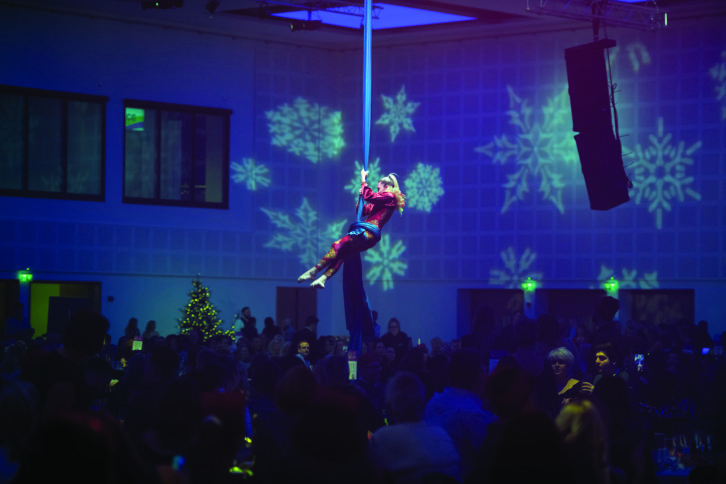
Both Dan Aldridge, commercial and projects director at Stage Electrics and Simon Cooper realised that by being able to create their own specification advantages of cost and efficiencies could be achieved for all parties — notably that the entire workflow would be in the hands of a single contractor.
Sound reinforcement
The sound reinforcement in the Main Hall functions independent of the PA/VA. For this, Stage Electrics provided 18 TTL 6-A elements, 10 TTL 6-AS active bass modules with RCF SUB 8006-AS providing further LF extension, all controlled using RCF’s proprietary RD Net. The three-way TTL 6-A line source is equipped with two 12in low frequencies woofers, four 6.5in midranges and a 3in voice coil compression driver while the TTL 6-AS contains three 12in woofers. Flexible and quick to rig, this scalable system can be set up as a one-box solution or expanded into a complete column, optimised by allowing the TTL 6-A tilt angle to be set accordingly.
A further six RCF EVOX 10 and four EVOX 12, along with the HD 10-A, HD 12-A and SUB 8006-AS have been provided as a portable roll-in/roll-out system for use in their 15 flexible meeting rooms, in addition to Media M 801 for further reproduction purposes, including background.
Mick Butler explains: “TTL 6-A can do all that and as it’s a line source system with wide horizontal and controlled vertical pattern — you don’t need to do comprehensive calculations every time you reconfigure the room.” Hosting such varied content, it was vital the ICCW could turn the spaces round quickly to accommodate the incoming corporate events, and the specific sound requirements.
You may also be interested in:
- d&b completes first V-Series point source install in India
- Clair Brothers delivers ‘unconventional’ audio upgrade in South Korea art centre
The addition of RCF’s DXT 9000 component became the icing on the cake after a completely separate zonal system had been ruled out. Both Aldridge and Cooper sensed they could achieve significant cost savings without compromise. “There were discussions in the office and there was only one company we would feel comfortable in putting forward because we wanted outstanding quality both for evacuation and the background music system,” says Aldridge.
“At that point we were very much in the hands of Francesco Venturi,” adds Simon Cooper. “RCF has a track record in large scale PA/VA and so it became a turnkey job. Francesco came up with the proposal … and 771 speakers later …!”
In fact, virtually every room has an RCF speaker, whether PL 70EN ceiling speakers, horns, BS 5EN pendant speakers or DP 1420EN aluminium sound projectors. Venturi confirms that RCF’s integrated site-wide PA/VA solution also needed to meet all standards in terms of emergency purposes, while allowing for general entertainment contributions plus background music reproduction in common areas, along with suitable voice reinforcement in meeting rooms for conferencing. “This would require a single infrastructure of EN54-24 certified speakers,” he recalls.” Integrating these facilities in a single solution would maximise performances, make the application more cost-effective and reduce installation efforts.”
Challenges
But he faced two main challenges in submitting a consistent technical proposal for speaker deployment since, in addition to the reconfigurable main hall, the ICCW is a five-storey building, with a three-floor entrance atrium, meeting rooms, two car park levels and kitchens, as well as a 1,500 raked seating auditorium. “After considering Stage Electrics’ requirements we came up with the most fitting topology for every space, considering all parameters,” says Venturi.
Regarding EN54-16 certified electronics, topology had to deal with the building layout as well, being distributed in the three available technical rooms, sharing monitored data and audio (Dante standard) upon an Ethernet fibre ring-configured network. Venturi states: “Besides the emergency facilities, the VA system needed to allow for local inputs broadcast on a zonal basis supporting a third-party audio-over-IP distribution system that manages routing and room combining capability by means of wireless control surfaces.”
While RCF’s DXT9000 platform would meet all requirements and VA standards, additional pro audio devices would exist as a separate system, outside the scope of voice alarm.
Outside the conferencing spaces the large atrium presented a particular challenge with regard to STI, notes Simon Cooper. This was successfully overcome, with the proposed design validated by EASE measurements, based upon predicted performances.
Consistent design
This approach fulfilled the pre-conditions for a consistent design. In the main hall, DP 1420EN aluminium sound projectors, deployed at a height of nine metres from floor level on a rain-diffusion basis, allow for a measured average STIPA figure that exceeds performance requirements of the Voice Alarm standard.
Finally, the client turned to RCF’s wiring department for PA/VA rack building, device wiring, testing and pre-configuration. Acceptance testing activity with Stage Electrics was also managed at RCF’s Reggio Emilia HQ. The final count consisted of six cabinets housing EN54-16 certified electronics (matrices and amplifiers), EN54-4 certified battery chargers for secondary power feed (including batteries), distributed in the three technical rooms and interconnected on an Ethernet fibre ring-configured network supported by dedicated network switches programmed by RCF.
The PA/VA installation was commissioned by RCF personnel alongside key Stage Electrics team members, comprising Simon Cooper, technical project manager Chris Brant, site team leader Aaron Godsmark and commissioning engineer Steve Chappell. They worked both on the PA/VA and the wider technical packages; these included lighting control in all spaces within the venue, truss and motor packages, technical equipment inventory, technical facility panels, custom power panels, audio, video, DMX, optical fibre and structured network cable infrastructure, and equipment racks.
In summary, Venturi confirms that the RCF application has been fully approved by the customer, and is in line with RCF Engineering Support Group’s own design targets.
Speaking of the success of the integration ICCW head of technical services, Simon Denman-Ellis, comments: “I think what the team liked most is the ease of use with the RCF systems. Everything just works seamlessly, a real plug and play set-up but with the high-end sound and reliability you would expect to find in a much more complex system.”
www.rightsolution.co.uk
www.rcf.it
www.stage-electrics.co.uk

